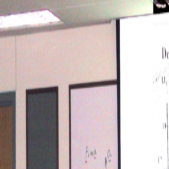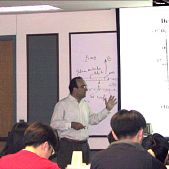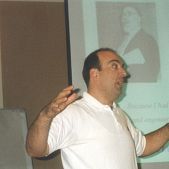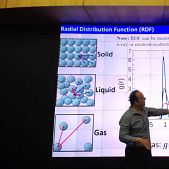
Developed a new system to classify the shapes of red blood cells
George Karniadakis is the Charles Pitts Robinson and John Palmer Barstow Professor of Applied Mathematics at Brown University.
He was born in 1959, in Crete, Greece. He studied Mechanical Engineering at the National Technical University of Athens. He received his S.M. (1984) and Ph.D. (1987) from Massachusetts Institute of Technology. Karniadakis was appointed Lecturer in the Department of Mechanical Engineering at MIT in 1987 and subsequently he joined the Center for Turbulence Research at Stanford / Nasa Ames. He joined Princeton University as Assistant Professor in the Department of Mechanical and Aerospace Engineering and as Associate Faculty in the Program of Applied and Computational Mathematics. He was a Visiting Professor at Caltech (1993) in the Aeronautics Department. He joined Brown University as Associate Professor of Applied Mathematics in the Center for Fluid Mechanics on January 1, 1994. Since 2000, he has been a visiting professor and senior lecturer of Ocean/Mechanical Engineering at Massachusetts Institute of Technology.
Scientists led by him have developed a new system to classify the shapes of red blood cells in a patient’s blood, using a computational approach known as deep learning. The findings, published in PLOS Computational Biology, could potentially help doctors monitor people with sickle cell disease.
To automate the process of identifying red blood cell shape, Mengjia Xu of Northeastern University, China, and colleagues developed a computational framework that employs a machine-learning tool known as a deep convolutional neural network (CNN). The new framework uses three steps to classify the shapes of red blood cells in microscopic images of blood. The researchers validated their new tool using 7,000 microscopy images from eight sickle cell disease patients.
“We have developed the first deep learning tool that can automatically identify and classify red blood cell alteration, hence providing direct quantitative evidence of the severity of the disease,” says study co-author George Karniadakis.
The research team plans to further improve their deep CNN tool and test it in other blood diseases that alter the shape and size of red blood cells, such as diabetes and HIV. They also plan to explore its usefulness in characterizing cancer cells.
Karniadakis has been honored with numerous awards. In 2015 he received the SIAM’s 2015 Ralph E Kleinman Award for “many outstanding contributions to Applied Mathematics in a broad range of areas, including computational fluid dynamics, spectral methods and stochastic modeling” and also the 2015 MCS Wiederhielm Award “for the most highly cited original article in Microcirculation over the previous five year period for the paper, Blood Flow and Cell-Free Layer in Microvessels.” He is also the recipient of the CFD award (2007) and the J Tinsley Oden Medal (2013) by the US Association in Computational Mechanics.












